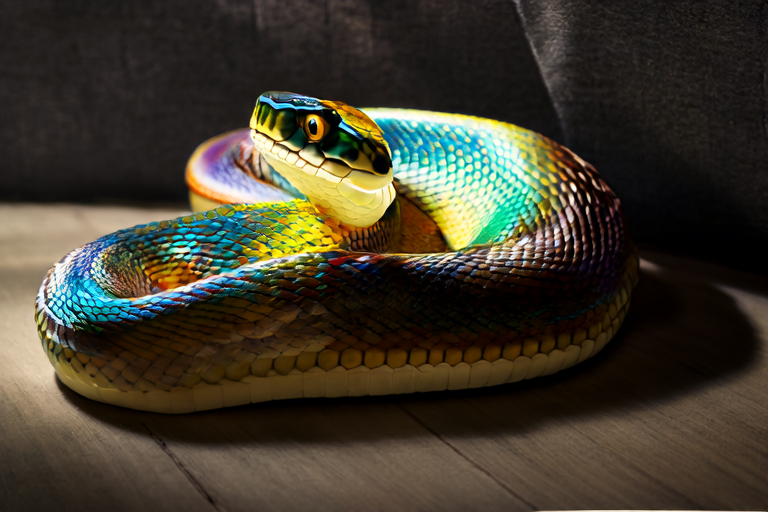Unraveling the Mystique of the Rainbow Boa: A Complete Care Guide
Introduction to Rainbow Boas
The rainbow boa (Epicrates cenchria) is a captivating snake species known for its iridescent scales that shimmer in a spectrum of colors under light. Native to Central and South America, these boas are popular among reptile enthusiasts due to their striking appearance and relatively docile temperament. This comprehensive guide will help you understand how to provide optimal care for your rainbow boa.
Habitat Setup
Creating an environment that mimics the boa’s natural habitat is crucial for its well-being. Rainbow boas thrive in tropical climates with high humidity levels, so it’s important to replicate this within their enclosure.
- Enclosure Size: Juveniles require at least a 20-gallon tank, while adults need a minimum of 40 gallons or larger.
- Substrate: Use a substrate that retains moisture but isn’t easily ingested. Cypress mulch, coconut fiber, or sphagnum moss are excellent choices.
- Temperature and Humidity: Maintain daytime temperatures between 80°F and 85°F (27°C-29°C) and nighttime temperatures around 75°F (24°C). The humidity should be kept between 60% and 80%, which can be achieved through regular misting.
- Hiding Spots: Provide multiple hiding spots throughout the enclosure to reduce stress.
- Water Source: A shallow water dish large enough for the boa to soak in should always be available.
Dietary Needs
Rainbow boas are carnivorous and primarily feed on rodents such as mice and rats. It’s essential to offer appropriately sized prey items based on the boa’s girth. Younger snakes may eat every few days, whereas adults can be fed once every week or two.
- Prey Size: Prey should be no larger than the widest part of the snake.
- Feeding Frequency: Adjust feeding frequency according to age and size.
- Handling Prey: Always thaw frozen prey thoroughly before offering it to your snake.
Health Concerns
Regular veterinary check-ups are vital for maintaining the health of your rainbow boa. Common issues include respiratory infections, parasites, and metabolic bone disease (MBD), which can result from calcium deficiency.
- Respiratory Infections: Signs include wheezing, nasal discharge, or difficulty breathing. Prompt treatment by a veterinarian specializing in reptiles is necessary.
- Parasites: Regular fecal examinations can detect internal parasites. External parasites like mites require immediate attention to prevent infestation.
- Metabolic Bone Disease: Symptoms include swollen jaw, bumps along the spine, and reluctance to move. Ensuring proper lighting and providing a balanced diet rich in calcium can help prevent MBD.
Handling Tips
Rainbow boas generally have calm dispositions and can become quite tame with consistent handling. However, there are some guidelines to follow to ensure safety and comfort.
- Frequency: Handle your snake regularly but avoid over-handling, especially after feeding.
- Support: Always support the boa’s body fully when handling.
- Temperature: Avoid handling if the ambient temperature is too cold, as this could stress the snake.
- Signs of Stress: Be aware of signs such as hissing, thrashing, or attempting to bite, which indicate the snake is uncomfortable.
Breeding Information
Breeding rainbow boas requires careful planning and specific environmental conditions. Breeding season typically occurs during late autumn or early winter.
- Courtship: Males may exhibit courtship behaviors such as tongue flicking and body rubbing.
- Brumation: Prior to breeding, snakes undergo a period of reduced activity called brumation.
- Laying Eggs: Females lay clutches of eggs, usually between 10-20, which they incubate externally.
- Nurturing Hatchlings: Once hatched, baby rainbow boas should be housed separately and provided with smaller prey items.
Fascinating Facts About Behavior and Natural History
Rainbow boas exhibit intriguing behaviors that reflect their unique evolutionary adaptations.
- Shimmering Scales: Their iridescent scales are caused by tiny ridges on each scale that refract light, creating a rainbow effect.
- Behavioral Adaptations: These snakes are nocturnal and spend much of their time in burrows or hidden crevices.
- Defense Mechanisms: When threatened, rainbow boas may vibrate their tail to produce a rattling sound similar to that of a rattlesnake.
- Communication: They use chemical signals called pheromones to communicate with others of their kind.
